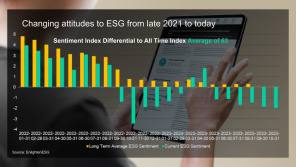
Article 4 / 4
Guide to Responsible InvestingResponsible and sustainable investing are not the same

There is a misconception that responsible investing is the same as sustainable, ethical, impact and socially responsible investing, according to the Principles for Responsible Investment.
Responsible investing, the body says, is a “strategy and practice to incorporate environmental, social and governance factors in investment decisions and active ownership. It complements traditional financial analysis and portfolio construction techniques”.
Will McIntosh-Whyte, fund manager of the Rathbone Greenbank Multi-Asset Portfolio funds, says there are multiple approaches to responsible investing, as well as a variety of ways to analyse companies for their sustainability credentials.
According to the PRI, approaches to responsible investing are typically a combination of ESG incorporation and active ownership.
| ESG incorporation: considering ESG issues when building a portfolio | Active ownership or stewardship: improving investees' ESG performance | |||
| ESG issues can be incorporated into existing investment practices using a combination of three approaches: integration, screening and thematic. | Investors can encourage the companies they are already invested in to improve their ESG risk management or develop more sustainable business practices. | |||
| Integration | Screening | Thematic | Engagement | Proxy voting |
| Explicitly and systematically including ESG issues in investment analysis and decisions, to better manage risks and improve returns. | Applying filters to lists of potential investments to rule companies in or out of contention for investment, based on an investor’s preferences, values or ethics. | Seeking to combine attractive risk-return profiles with an intention to contribute to a specific environmental or social outcome. Includes impact investing. | Discussing ESG issues with companies to improve their handling, including disclosure, of such issues. Can be done individually, or in collaboration with other investors. | Formally expressing approval or disapproval through voting on resolutions and proposing shareholder resolutions on specific ESG issues. |
| Source: Principles for Responsible Investment | ||||
“While the end goal [of responsible investing] is often similar – to do the right thing for the environment and society – we think it's crucial to understand the differences between each approach because it helps investors to make informed choices about where they are putting their money,” says McIntosh-Whyte.
“While not a new concept, responsible investing has accelerated into the mainstream, but terms such as responsible, sustainable, ESG and impact investing are just a few of the terms that are frequently used interchangeably. The cynic in me also fears that this confusion can be exploited.”
Indeed, research from Boring Money found that greenwashing was one of the biggest concerns for financial advisers when it comes to ESG. Seven in 10 (69 per cent) said it was a concern for their business, with one in five (20 per cent) saying they were very concerned about the risk, and half (49 per cent) saying they were somewhat concerned.
According to the Treasury, the lack of common definitions around environmental sustainability is leading to greenwashing, when misleading or unsubstantiated claims about environmental performance are made by businesses or investment funds about their products or activities.
In October it announced the chancellor had published a roadmap outlining future standards for environmental reporting to “weed out” greenwashing and support the transition to a greener financial system.
Ryan Medlock, senior investment development manager at Royal London, says: “Regulation is imminent. The Treasury’s Greening Finance: A Roadmap to Sustainable Investing [paper] confirms that, along with the Financial Conduct Authority, they are looking to implement potential requirements including understanding investors’ sustainability preferences to ensure the suitability of advice.”
According to the Treasury's policy paper, the lack of common definitions makes it difficult for companies and investors to clearly understand the environmental impact of their decisions and can lead to consumer harms.
“This risks limiting the flow of capital into sustainable investments and ultimately slowing the UK’s progress to tackle climate change and other environmental challenges,” it adds.
The roadmap also details a future UK green taxonomy that aims, among other things, to create “clarity and consistency for investors. Investors will be able to easily compare the environmental performance and impact of companies and investment funds to inform their financial decisions”.
The Treasury’s publication of the roadmap follows an earlier announcement that the government would work with the FCA to create a new sustainable investment label, which it also referred to as a quality stamp, so consumers can clearly compare the impacts and sustainability of their investments.
Following in the EU’s footsteps
The awaited UK Sustainability Disclosure Requirements is reminiscent of the EU’s Sustainable Finance Disclosure Regulation.
But as Jamie Govan, senior ESG investment manager at Abrdn, points out, different countries use different terms. “I think a big problem you face as you go around the globe is, how do you get different countries to agree on that terminology?” he adds.
In a survey of 11,000 individuals across 11 countries in Europe and Asia, commissioned by Architas, 'sustainable investing' was the most recognised term by 48 per cent in Europe and 54 per cent in Asia.
A third recognised the term ‘green investing’ or ‘responsible investing’. Meanwhile, the term ‘ESG’ was recognised by one in five investors (22 per cent) in Europe and a third (36 per cent) in Asia.
While the industry awaits the implementation of SDR, Nathalie Wallace, global head of sustainable investing at Natixis Investment Managers, cites the CFA Institute’s Global ESG Disclosure Standards for Investment Products – a set of voluntary standards for disclosing how an investment product considers ESG issues in its objectives, investment strategy and stewardship activities.
Wallace remarks: “Standards are emerging all over the place. They sometimes add a bit of confusion, but I think they are actually increasingly helping to really define the difference between ESG integration and ESG investments.”
According to the CFA Institute, it is “not uncommon to see the same term referring to different ESG approaches or types of investment products, or to see different terms referring to the same ESG approach or type of investment products. The confluence of the aforementioned factors has resulted in an increase in greenwashing”.
The CFA Institute says ESG terminology is often a barrier to investors’ understanding of the ESG approaches used in an investment product, giving the example of investment managers at times using words with a commonly understood meaning but which have a specific meaning when used in the context of ESG investing.
Medlock at Royal London likewise says confusion with terminology and the lack of an industry standard is a barrier for some advisers starting a client conversation around responsible investment, especially with clients who have not expressed a preference in responsible investing before.
“It’s difficult to be authentic if you don’t know how to label different approaches and subsequently probe at clients’ preferences. The lack of a labelling standard can cause a disconnect between what product manufacturers are producing and what advisers are recommending to their clients.”
He adds: “It’s imperative that advisers... know how to probe at managers’ approaches. If not, it undoubtedly increases the risk of greenwashing because we know a fund’s name will not always reflect what is happening under the lid.”
Medlock reflects how, “at times, it can feel like we’re all speaking different languages and using terms interchangeably.
“We know the Treasury is working with the FCA in developing a new labelling regime and this will significantly help everyone in the industry.
“Until then I’d encourage advisers to familiarise themselves with concepts like the spectrum of capital and the Investment Association’s responsible investment framework. Getting familiar with the different terms and definitions can really help support better client conversations in this area.”
Chloe Cheung is a features writer at FTAdviser





